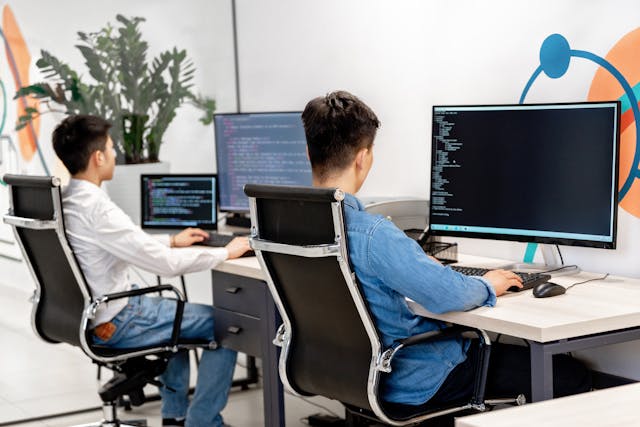What is Application Software? Uses and Types of Application Software
Do you know what is an application software? Can you define application software and its type and uses? Choosing the right software for your use is very important to boost productivity.
There are many software ready-made and custom-built designs for the user’s needs. By using them you can perform your tasks easily. You should understand the importance and why you need them before using them.
Before you dive into what is the best application software for you. Let’s start with what is application software.
Table of Contents
What is Application Software?
Application software refers to computer programs or software applications that are designed to perform specific tasks or functions for end users.
It is a type of software that enables users to accomplish various activities on their computers or other devices, such as smartphones or tablets. Application software is distinct from system software, which includes the operating system and other fundamental components necessary to run and manage computer hardware.
Application software is typically installed and executed by end users to perform specific tasks based on their needs and preferences. Hope you are now clear about what is application software. Let’s see the types of application software.
Types of Application Software
Application software plays a vital role in our daily lives, offering a wide range of functionalities and enhancing our productivity, communication, entertainment, education, and much more. In this article, we will explore the different types of application software, how they work, popular examples, the importance of regular updates and security, and the future of application software.
We will also read about What the application software does. uses of application software, software application types, examples of application software, and best application software for your business.
Let’s see the list of application software types.
1. Productivity Software
Productivity software is the best application software for businesses that empowers users to create, edit, and manage various types of documents, presentations, spreadsheets, and notes. It includes:
- Word Processing Software – Word processing software is an affordable application software solution that allows users to create and format text-based documents. It provides features such as spell check, formatting options, and the ability to insert images and tables. Popular examples include Microsoft Word, Google Docs, and Apple Pages.
- Spreadsheet Software – Spreadsheet software enables users to perform complex calculations, analyze data, and create charts and graphs. It is widely used in finance, accounting, and data analysis. Microsoft Excel, Google Sheets, and Apache OpenOffice Calc are well-known spreadsheet applications.
- Presentation Software – Presentation software helps users create visually appealing slideshows for educational, professional, or personal purposes. It allows users to incorporate text, images, animations, and multimedia elements. Microsoft PowerPoint, Google Slides, and Prezi are widely used presentation tools.
- Note-taking Software – Note-taking software assists users in capturing and organizing their thoughts, ideas, and important information. These applications often provide features such as syncing across devices, search functionality, and the ability to attach multimedia files. Popular note-taking apps include Evernote, Microsoft OneNote, and Google Keep.
2. Communication Software
Communication software facilitates seamless interaction and collaboration among individuals or groups. It includes:
- Email Clients – Email clients allow users to send, receive, and organize emails. They often offer features like attachments, email filtering, and calendar integration. Popular email clients include Microsoft Outlook, Gmail, and Mozilla Thunderbird.
- Instant Messaging Applications – Instant messaging applications enable real-time text-based communication between individuals or groups. They support features like group chats, file sharing, and voice and video calls. WhatsApp, Slack, and Microsoft Teams are examples of widely used instant messaging apps.
- Video Conferencing Software – Video conferencing software enables remote communication through audio and video connections. It allows participants to have virtual meetings, webinars, or online presentations. Zoom, Microsoft Teams, and Cisco Webex are popular video conferencing tools.
- Voice over IP (VoIP) Software – VoIP software allows users to make voice and video calls over the internet, often at a lower cost compared to traditional phone calls. It is used for both personal and business communication. Skype, WhatsApp, and Google Meet are prominent VoIP applications.
3. Multimedia Software
Multimedia software focuses on creating, editing, and consuming various forms of media content. Do you know how to choose the right application software? Let’s read.
- Media Players – Media players enable users to play audio and video files in different formats. They often come with features like playlists, equalizers, and subtitle support. Popular media players include VLC Media Player, Windows Media Player, and iTunes.
- Video Editing Software – Video editing software provides tools for editing, modifying, and enhancing video footage. It offers features like trimming, merging, adding effects, and applying transitions. Adobe Premiere Pro, Final Cut Pro, and DaVinci Resolve are widely used application software for video editing.
- Graphic Design Software – Graphic design software enables users to create visually appealing graphics, illustrations, and designs. It includes features like image manipulation, vector graphics creation, and typography tools. Adobe Photoshop, CorelDRAW, and GIMP are popular application software for graphic design.
- Audio Editing Software – Audio editing software allows users to record, edit, and enhance audio files. It provides features like waveform visualization, noise reduction, and audio effects. Adobe Audition, Audacity, and GarageBand are well-known audio editing tools.
4. Entertainment Software
Entertainment application software provides various forms of digital entertainment, including games, music streaming, and movie/TV streaming. It includes:
- Video Games – Video games offer interactive and immersive experiences for entertainment and leisure. They encompass various genres such as action, adventure, strategy, and simulation. Popular video game titles include Fortnite, Minecraft, and Assassin’s Creed.
- Music Streaming Services – Music streaming services provide access to an extensive collection of songs, albums, and playlists. Users can stream music on-demand, discover new artists, and create personalized playlists. Spotify, Apple Music, and Amazon Music are prominent music streaming platforms.
- Movie and TV Streaming Services – Movie and TV streaming services offer a vast library of movies, TV shows, and documentaries for on-demand viewing. They often provide original content and allow users to stream videos across different devices. Netflix, Hulu, and Amazon Prime Video are popular streaming services.
- Virtual Reality (VR) Applications – Virtual reality applications offer immersive experiences by creating simulated environments. They are used for gaming, training, educational purposes, and virtual tours. Examples include Oculus Rift, HTC Vive, and PlayStation VR.
5. Education and Reference Software
Application software for educational purposes assists users in learning, acquiring knowledge, and accessing reference materials. They include:
- E-Learning Platforms – E-learning platforms provide online courses and educational resources for self-paced or instructor-led learning. They often include interactive modules, quizzes, and certification options. Examples include Coursera, Udemy, and Khan Academy.
- Language Learning Applications – Language learning applications help users acquire new languages through interactive lessons, vocabulary drills, and language exercises. They often offer features like speech recognition and progress tracking. Duolingo, Rosetta Stone, and Babbel are popular language-learning apps.
- Encyclopedia Software – Encyclopedia software provides comprehensive reference material on various subjects. It offers detailed articles, images, and cross-referencing capabilities. Examples include Encarta, Wikipedia, and Encyclopedia Britannica.
- Dictionary and Thesaurus Software – Dictionary and thesaurus software provides definitions, synonyms, antonyms, and examples of word usage. They often include language tools like spell checkers and word suggestion features. Oxford English Dictionary, Merriam-Webster, and WordWeb are widely used dictionary applications.
6. Utility Software
Utility software comprises tools that optimize and maintain computer systems. They offer functionalities such as system maintenance, data protection, and file management. It includes:
- Antivirus Software – Antivirus software protects computers from malware, viruses, and other security threats. It scans files and programs, detects and removes malicious software, and provides real-time protection. Examples include Norton Antivirus, McAfee, and Avast.
- Disk Cleanup and Optimization Tools – Disk cleanup and optimization tools help users free up disk space, manage system performance, and organize files and folders. They often include features like disk defragmentation, duplicate file removal, and startup management. CCleaner, Advanced SystemCare, and Glary Utilities are well-known optimization tools.
- File Compression Software – File compression software reduces the size of files and folders, making them easier to store and transfer. It uses compression algorithms to compress and decompress data. Popular examples include WinRAR, 7-Zip, and WinZip.
- Backup and Recovery Software – Backup and recovery software enables users to create copies of important files and restore them in case of data loss or system failures. It provides features like automated backups, incremental backups, and recovery options. Acronis True Image, EaseUS Todo Backup, and Carbonite are popular backup solutions.
However, it’s important to check out options that are disconnected from the internet, like an air gap backup, which keeps your sensitive information offline and isolated from the public internet so it can’t be hacked.
7. Financial Software
Financial software is the latest trend in application software that assists individuals and businesses in managing their finances, accounting, and banking. It includes:
- Accounting Software – Accounting software helps businesses track financial transactions, manage budgets, and generate financial reports. It often includes features like invoicing, inventory management, and payroll processing. QuickBooks, Xero, and Sage Intacct are widely used accounting applications.
- Tax Preparation Software – Tax preparation software simplifies the process of preparing and filing tax returns. It provides step-by-step guidance, and tax calculators, and ensures compliance with tax laws. TurboTax, H&R Block, and TaxAct are prominent tax preparation tools.
- Personal Finance Applications – Personal finance applications help individuals manage their personal budgets, track expenses, and set financial goals. They often offer features like expense categorization, bill reminders, and investment tracking. Mint, Personal Capital, and YNAB (You Need a Budget) are popular personal finance apps.
- Online Banking Applications – Online banking applications allow users to manage their bank accounts, make transactions, and access financial services online. They often include features like balance inquiries, fund transfers, and mobile check deposits. Examples include Chase Mobile, Bank of America Mobile Banking, and PayPal.
8. Travel and Navigation Software
Travel and navigation software assists users in planning trips, navigating routes, and booking accommodations. It includes:
- GPS Navigation Applications – GPS navigation applications provide turn-by-turn directions, real-time traffic updates, and offline maps for navigation. They often include additional features like points of interest, voice guidance, and alternate route suggestions. Google Maps, Waze, and Apple Maps are well-known navigation apps.
- Travel Planning Applications – Travel planning applications help users research and plan trips, find flights and accommodations, and create itineraries. They often offer features like price comparisons, travel recommendations, and reviews. Examples include TripAdvisor, Kayak, and Airbnb.
- Flight and Hotel Booking Applications – Flight and hotel booking applications allow users to search for flights, compare prices, and book airline tickets and hotel rooms. They often provide features like flexible date searches, loyalty program integration, and alerts for price drops. Expedia, Booking.com, and Skyscanner are popular booking platforms.
- Language Translation Applications – Language translation applications assist users in translating text or speech from one language to another. They often support multiple languages and provide features like offline translation and voice input. Google Translate, Microsoft Translator, and iTranslate are well-known translation apps.
How Application Software Works
Application software relies on a combination of user interfaces and backend processes to perform its functions. Companies use application software for project management, custom application software development, training, etc. Let’s explore these aspects:
1. User Interface
The user interface (UI) is the front-end component of application software that enables users to interact with the software. Different types of interfaces include:
Graphical User Interfaces (GUI)
Graphical user interfaces use visual elements like windows, icons, menus, and buttons to present information and receive user input. They provide a user-friendly and intuitive experience. Users can interact with GUIs using a mouse, keyboard, or touch input.
Command-Line Interfaces (CLI)
Command-line interfaces allow users to interact with the software by typing commands in a text-based environment. They require users to have a certain level of technical knowledge and familiarity with specific commands and syntax.
Touch-based Interfaces
Touch-based interfaces are designed for devices with touchscreens, such as smartphones and tablets. They enable users to interact directly with the screen by tapping, swiping, pinching, and other gestures. Touch-based interfaces are intuitive and widely used in mobile applications.
2. Backend Processes
Behind the scenes, application software relies on various backend processes to perform its tasks. These processes include:
Data Processing
Data processing involves manipulating, analyzing, and transforming data to generate meaningful output. Application software uses algorithms and data structures to process data efficiently and accurately.
Database Management
Database management involves storing, organizing, and retrieving data efficiently. Application software interacts with databases to store and retrieve information, perform queries, and maintain data integrity.
Networking and Communication
Networking and communication processes enable application software to connect with remote servers, exchange data over networks, and communicate with other devices or applications. This allows for functionalities like online collaboration, data synchronization, and real-time updates.
File Management
File management processes involve creating, organizing, and manipulating files and directories. Application software interacts with the file system to read and write files, manage file permissions, and handle file-related operations.
Popular Application Software Examples
Let’s explore some popular examples of application software across different categories:
1. Microsoft Office Suite
Microsoft Office Suite is a comprehensive productivity suite that includes several applications commonly used in professional settings:
- Word: A word processing software for creating and editing documents.
- Excel: A powerful spreadsheet software for data analysis and calculations.
- PowerPoint: A presentation software for creating visually engaging slideshows.
- Outlook: An email client and personal information manager for managing emails, calendars, and contacts.
2. Adobe Creative Cloud
Adobe Creative Cloud is a collection of applications used for creative tasks like graphic design, photo editing, and video production:
- Photoshop: A professional image editing software with advanced editing tools and features.
- Illustrator: A vector graphics editor used for creating illustrations, logos, and other scalable graphics.
- Premiere Pro: A video editing software for professional video production and post-production.
- InDesign: A desktop publishing software for creating print and digital media, such as brochures, magazines, and eBooks.
3. Social Media Applications
Application software for social media marketing connects individuals and facilitates online communication and sharing:
- Facebook: A popular social networking platform for connecting with friends, sharing updates, and joining communities.
- Instagram: A photo and video-sharing platform known for its visual content and creative filters.
- Twitter: A microblogging platform for sharing short messages, and news, and engaging in conversations.
- LinkedIn: A professional networking platform used for connecting with colleagues, job searching, and professional development.
4. Entertainment Streaming Services
Entertainment streaming services provide on-demand access to a wide range of movies, TV shows, and music:
- Netflix: A subscription-based streaming platform offering a vast library of movies, TV series, and original content.
- Spotify: A music streaming service that allows users to access millions of songs, create playlists, and discover new music.
- Hulu: A streaming platform offering a combination of current and classic TV shows, movies, and original content.
- Disney+: A subscription-based streaming service featuring Disney, Pixar, Marvel, Star Wars, and National Geographic content.
5. Web Browsers
Web browsers enable users to access and browse websites on the Internet:
- Google Chrome: A widely used web browser known for its speed, security features, and extensive plugin ecosystem.
- Mozilla Firefox: An open-source web browser focused on privacy, customization, and compatibility with web standards.
- Microsoft Edge: A web browser developed by Microsoft with a focus on performance, security, and integration with Windows.
- Safari: The default web browser for Apple devices, known for its speed, energy efficiency, and seamless integration with the macOS and iOS ecosystems.
The Importance of Regular Updates and Security
Do you know the Importance of application software and what are the application software security best practices? Let’s read.
1. Software Updates
Regular updates are crucial for application software. They bring several benefits:
Bug Fixes and Performance Enhancements
Software updates address known issues, bugs, and performance bottlenecks. They improve stability, fix crashes, and enhance overall performance, providing a better user experience.
New Features and Improvements
Updates often introduce new features, functionalities, and enhancements based on user feedback and technological advancements. They ensure that software remains competitive and relevant in a rapidly evolving digital landscape.
Security Patches and Vulnerability Fixes
Software updates address security vulnerabilities, protecting users from potential cyber threats and attacks. They patch vulnerabilities discovered through security research or reported by users, reducing the risk of data breaches and unauthorized access.
2. Cybersecurity Risks and Best Practices
Application software can be vulnerable to cybersecurity threats. It’s important to follow best practices to mitigate these risks:
Malware and Ransomware Threats
Malware, including ransomware, can compromise the security of application software and the data it handles. It’s crucial to use reputable antivirus software, keep it updated, and exercise caution when downloading files or clicking on suspicious links.
Phishing and Social Engineering Attacks
Phishing attacks attempt to trick users into revealing sensitive information or installing malicious software. It’s important to be vigilant and avoid clicking on suspicious email links or sharing personal information with unverified sources.
Importance of Strong Passwords
Using strong and unique passwords for application software accounts adds an additional layer of protection. Passwords should be complex, including a combination of uppercase and lowercase letters, numbers, and special characters.
Use of Two-Factor Authentication
Enabling two-factor authentication adds an extra layer of security by requiring an additional verification step, such as a unique code sent to a mobile device, along with the password. This reduces the risk of unauthorized access even if the password is compromised.
The Future of Application & Trends
The landscape of application software is continually evolving, driven by technological advancements and changing user needs. We should more focus on how to improve application software performance. Here are some trends that shape the future of application software:
1. Cloud-based Applications
Cloud computing has revolutionized the way software is delivered and accessed. There are many top application software development tools and cloud-based applications offer several benefits:
Benefits of Cloud Computing
Cloud-based applications allow users to access software and data remotely, without the need for local installations or storage. They provide scalability, flexibility, and cost-efficiency, as resources can be dynamically allocated based on demand.
Software as a Service (SaaS) Model
The Software as a Service (SaaS) model allows users to subscribe to and use software applications over the Internet. It eliminates the need for upfront software purchases and offers regular updates and maintenance as part of the subscription.
Collaborative Tools and Real-time Updates
Cloud-based applications facilitate collaboration by enabling real-time updates and seamless sharing of data and documents. Multiple users can work together, access the same files, and see changes in real-time, regardless of their geographical location.
2. Mobile Application Development
Mobile applications continue to gain popularity due to the widespread use of smartphones and tablets. However, many common challenges in application software development come during development. Let’s see Key trends in mobile app development include:
Growing Popularity of Mobile Apps
Mobile apps provide convenient access to services and information on the go. They offer personalized experiences, push notifications, and integration with device features like cameras, GPS, and sensors.
Cross-Platform Development Frameworks
Cross-platform development frameworks allow developers to build apps that run on multiple platforms, such as iOS and Android, using a single codebase. This reduces development time and costs while reaching a broader audience.
App Store Optimization (ASO) Techniques
App Store Optimization (ASO) techniques help improve the visibility and discoverability of mobile apps in app stores. ASO involves optimizing app metadata, keywords, screenshots, and user reviews to increase app downloads and user engagement.
3. Artificial Intelligence and Machine Learning Integration
Artificial intelligence (AI) and machine learning (ML) technologies are increasingly integrated into application software, offering advanced capabilities:
Smart Assistants and Voice Recognition
Smart assistants like Siri, Alexa, and Google Assistant utilize natural language processing and voice recognition to perform tasks, provide information, and interact with users. They enable hands-free and intuitive interaction with application software.
Predictive Analytics and Data Insights
AI and ML algorithms analyze vast amounts of data to provide predictive analytics and valuable insights. Application software leverages these technologies to offer personalized recommendations, predictive modeling, and data-driven decision-making.
Personalized User Experiences
AI and ML enable application software to deliver personalized user experiences by understanding user preferences, behavior, and context. This includes personalized content recommendations, tailored interfaces, and adaptive features.
Conclusion
Application software plays a vital role in our daily lives, offering a wide range of functionalities across various domains. From productivity and communication to entertainment and education, application software empowers us to be more efficient, connected, and creative.
As technology continues to advance, the future of application software holds exciting possibilities. Cloud-based applications, mobile app development, and AI integration will shape the way we interact with software, providing greater accessibility, collaboration, and intelligent automation.
In this rapidly evolving landscape, it’s important to prioritize regular software updates and security practices to safeguard against cyber threats. By staying informed, embracing innovation, and leveraging the power of application software, we can navigate the digital world with confidence and harness its full potential.
Frequently Asked Questions –
1. What is the purpose of application software?
Application software is designed to perform specific tasks or functions for end users, such as word processing, data management, multimedia editing, and communication.
What is the difference between application software and system software?
Application software refers to programs designed for specific user tasks, while system software includes the operating system and other fundamental components necessary to manage computer hardware and provide a platform for running applications.
2. What is utility software used for?
Utility software provides system-level functionalities and tools to manage and optimize computer performance. Examples include antivirus software, disk cleanup utilities, and file compression programs.
3. Are video games considered software applications?
Yes, video games are a type of application software that provides entertainment and interactive experiences for users.
4. How can I install an application on my computer or device?
To install application software, you typically need to download it from a trusted source or install it from a physical media (such as a CD or DVD). Once downloaded or inserted, follow the installation instructions provided by the software.
5. Can I customize the application to suit my needs?
Some application software allows customization and personalization based on user preferences. However, the extent of customization options varies depending on the software.









